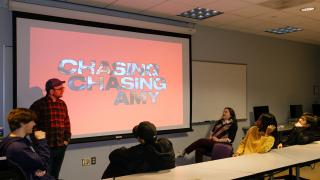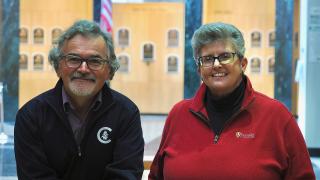
Prior to the event, Assistant Research Scientist Claudia Walters shares how geographic information systems technology is being used around the world—from predicting Ebola outbreaks in West Africa to mapping crime in Detroit.

What is GIS?
A geographic information system (GIS) is a computer-based system that allows you to map, model, query and analyze data that have a spatial component. GIS is used in a variety of fields—from environmental science, business, health, public safety to architecture—to understand relationships, patterns and trends.
Why is this technology important?
GIS helps government, business and industry improve their decision making, increase efficiency and communicate more effectively.
One example that highlights the power of GIS is disaster management. In the aftermath of supertyphoon Hayan, GIS professionals locally and around the world created maps of hardest hit areas based on satellite images, helped map the location of victims who needed to be rescued, and provided logistical support for disaster relief efforts.
Another very current example is the Ebola outbreak. By mapping the approximate locations of cell phone users in West Africa who dial emergency call centers, the Centers for Disease Control and Prevention are attempting to predict the onset and spread of Ebola outbreaks.
How has GIS evolved over time?
Roger Tomlinson is considered the “Father of GIS." He was working for an aerial survey in Canada when he was trying to find a way to collect and synthesize thousands of maps of the vast Canadian landscape. On an airplane trip in 1962, he struck up a conversation with the head of the Canada Land Inventory who had been charged with compiling a map-based catalog of the nation’s resources. Tomlinson ended up developing the Canadian Geographic Information System, the first functional Geographic Information System.
As technology has evolved, so has the functionality and the relative ease of using these systems. Unlike mainframes in the early days, now everyone with a PC can run a GIS in their homes. While the cost of commercial GIS software is prohibitive for most people, the trend toward open source software is also found in GIS. There are some good alternatives to commercial GIS packages now available. Some of the more exciting developments in recent years are the increasing use of online GIS applications where organizations make their spatial data bases available to users in the form of interactive maps, where multiple users can collaborate on the same data set, and where the public can be included in data collection efforts.
What are some ways people are using GIS to positively impact the community?
On GIS Day, there will be a series of presentations detailing uses of GIS in this area. In the morning session, there will be four presenters talking about how GIS can be utilized to help with community development efforts in Detroit. They will highlight how GIS can contribute to making informed decisions when allocating sparse resources. In the afternoon, there will be two presentations on analyzing crime data for detecting hot spots, as well as, presentations on uses of GIS in healthcare.
What's the most interesting use of GIS you've seen?
I just read a report where 80 people gathered locally, and more than 100 additional mappers joined in remotely, to map the infrastructure of a city in Congo. The mappers combined satellite images with features of the city’s infrastructure. By the end of the event, the participants had mapped 70 percent of the city.
Similar international efforts have taken place in the aftermath of natural disasters. Particularly in areas that lack the financial resources, open source mapping efforts have “democratized” mapping. But you don’t have to travel around the world to find similar examples. In Detroit, a group of volunteers has been mapping bike trails using Google Map and making those maps available to the public.
How are UM-Dearborn faculty and students using GIS?
UM-Dearborn faculty and students have been involved with projects delineating potential areas for wetland restoration in Lake Erie, mapping the conditions of bus stops in the city of Detroit, identifying stream deserts in the built-up urban landscape of the Metro region, helping identify potential sites for senior day care centers based on the demographics of neighborhoods, etc.
Where is GIS heading in the future?
GIS is already used widely in a number of fields. I believe its uses will only increase. In a time of limited resources, good quality data and good visualizations of that data are essential for decision making, as is the potential for modeling future scenarios.





